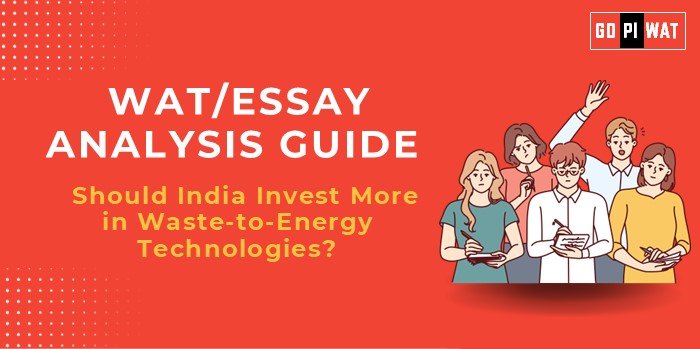📋 Written Ability Test (WAT)/Essay Analysis Guide
♻️ Should India Invest More in Waste-to-Energy Technologies?
🌟 Understanding the Topic’s Importance
WTE technologies align with India’s goals of sustainable urbanization and energy security, directly impacting environmental policy, public health, and economic growth.
🕒 Effective Planning and Writing
- ⏳ Time Allocation:
- Reading & Planning: 5 minutes.
- Writing: 20 minutes.
- Review: 5 minutes.
- 📖 Preparation Tips:
- Research recent WTE advancements and policies.
- Use credible data on waste generation and energy potential.
💡 Introduction Techniques
- 🔀 Contrast Approach: “While India struggles with untreated waste choking landfills, countries like Sweden turn waste into energy, achieving near-zero landfill dependency.”
- 🔧 Problem-Solution Approach: “India’s mounting waste crisis necessitates innovative solutions. WTE technologies present a dual benefit of waste management and energy generation.”
📑 Structuring the Essay Body
- 🏆 Achievements: Highlight operational plants, government policies, and potential energy benefits.
- 🔍 Challenges with Comparative Analysis: Discuss technological and social barriers, comparing India’s performance with global leaders.
- 🔭 Future Outlook: Propose solutions like public-private partnerships, better waste segregation, and international collaborations.
🎯 Concluding Effectively
- ⚖️ Balanced Conclusion: “India’s investment in WTE should balance environmental concerns with energy and waste management needs, supported by robust policies and public awareness.”
- 🌍 Global Perspective Conclusion: “India can emulate global leaders like Sweden by integrating advanced WTE technologies, fostering a sustainable future.”
📊 Analyzing Successes and Shortcomings
- ✔️ Key Achievements: Delhi’s operational plants, Swachh Bharat Mission integration.
- ❌ Ongoing Challenges: Feedstock quality, public resistance, cost-effectiveness.
- 🌏 Global Context: Sweden and Singapore’s success in waste management.
🔧 Recommendations for Sustainable Progress
- 📜 Mandate waste segregation at source for better WTE feedstock.
- 💰 Increase subsidies and incentives for WTE plants.
- ⚠️ Enforce stricter emission norms to address environmental concerns.
📚 Sample Short Essays
Balanced Perspective:
“India’s growing waste crisis necessitates urgent interventions like WTE, but careful planning and public engagement are critical for its success.”
Solution-Oriented:
“WTE technologies can address both waste and energy challenges, provided India adopts stringent segregation practices and emission norms.”
Global Comparison:
“India can draw inspiration from Sweden’s waste management model, integrating WTE into its urban planning for sustainable growth.”


